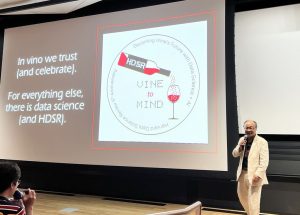Xiao-Li Meng writes:
Winston Churchill is known for his many memorable quotes, and for wine lovers, none more savory than his toast to Champagne: “In victory, I deserve it; in defeat, I need it.” As a staunch believer in Churchill’s chicken soup for life, I found it impossible to not pair “AI and Data Science: Integrating Artificial and Human Ecosystems” (June 13, 2024) with “Vine to Mind” the following day: two symposiums to commemorate the fifth anniversary of Harvard Data Science Review (HDSR).
Yet, there is more to this toast than mere celebration. Climate change, an urgent issue impacting various aspects of life, profoundly affects the wine industry. Winemakers, who plan with horizons stretching 50 to 150 years, face critical decisions regarding where to plant and how to cultivate resilient grape varieties. Despite the typically adverse narrative around climate change, for winemakers, it can present opportunities to discover new wine regions and develop unprecedented terroirs, delighting even the most experienced palates. Addressing these challenges and opportunities requires a nuanced understanding of climate trends—not only globally but on a localized scale, and that in turn requires much probative evidence to minimize the risk of wrong moves.
No surprise, then, that when I approached industry leaders to discuss potential themes for the Vine to Mind symposium, climate change emerged as a natural focus. The other key topic was equally significant: the uses of AI technologies in anything about wine, from viticulture to winemaking, and from wine marketing to consumer responses. Organized in collaboration with the Journal of Wine Economics, Vine to Mind therefore opened with morning sessions on wine economics, and on data and AI for the wine industry. The afternoon then transitioned into discussions on climate’s effects on grape cultivation and the broader impact of climate change on the wine industry.
Much of the symposium content will appear in HDSR issues 7.1 (January 2025) and 7.2 (April 2025). Those who are eager to have a taste can find selected talk videos from both symposiums on the YouTube channel of Harvard Data Science Initiative (https://www.youtube.com/@harvarddatascienceinitiati3320).
For readers who are curious about the actual wine tasting at the symposium, here’s what our guests sampled:
Reception: Champagne Perrier-Jouët Grand Brut NV; Kenwood Jack London Cabernet Sauvignon 2019; Ponzi Laurelwood Chardonnay 2021
Dinner: Champagne Bollinger Special Cuvée NV; William Fèvre Chablis Montée de Tonnerre 2018; Château L’Anseillan Bordeaux 2020; Opus One 2017; Robert Mondavi To Kalon Cabernet Sauvignon 2018; Catena Alta Malbec 2020.
Those familiar with HDSR’s commitment to inclusivity—everything data science and data science for everyone—might be concerned if we had not practiced what we preach. Surely this list is not for everyone—what about those who do not drink wine? No worries, this printed list deliberately conceals a delightful surprise. Robin Gong, in addition to her adventure in the culinary world (see her column in this issue), has been collecting data on the growing “NOLO” (no- or low-alcohol) trend in wine, which enabled us to also secure a sponsorship from Navarro vineyard. We served a Navarro grape blindly with dessert, and guests were invited to guess its identity. To everyone’s amusement, no one realized they were not even drinking wine! (I’ll leave the identity a mystery here as well, so readers can experiment with the four NO wines from Navarro to surprise your guests or yourselves.)
For anyone who has experienced blind tasting, this deception may not be so surprising. Blind tastings (or testing) are an invaluable way of exposing our biases, revealing just how challenging it can be to discern a myriad of revelatory and obfuscatory variations. Indeed, the much celebrated “Judgment of Paris” of May 23, 1976 (see https://www.simonandschuster.co.uk/books/Judgment-of-Paris/George-M-Taber/A-Gift-for-Wine-Lovers/9781416547891), or the Hollywood version, Bottle Shock (watch the trailer on https://www.youtube.com/watch?v=gYOvh1gE6I4), may shock those who yet need to appreciate fully the criticality of eliminating confounding factors in reaching scientific validity.
My editorial for the Vine to Mind symposium, set to appear in HDSR 7.1, reflects on a host of statistical issues and explorations generated by this landmark blind tasting, including Dennis Lindley’s Bayesian analysis of the tasting results (D.V. Lindley, 2006. Journal of Wine Economics, 1(1), 33–41).
As the dessert course for this XL-Files, for those who wonder how a statistician like myself found a path to partnering with leaders in the wine industry who generously donated all the wines as listed, all will be revealed in the next (several) XL-Files. Until then, pour yourself a responsible glass of grape juice—fermented or not—and tune in to Episode 43 of the HDSR podcast, “How Many Glasses of Wine a Day Keeps the Doctor Away?”
Cheers!

Xiao-Li Meng speaking at the “Vine to Mind” symposium in June 2024.